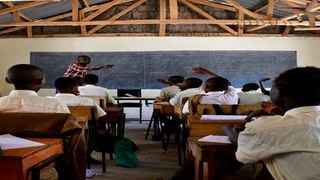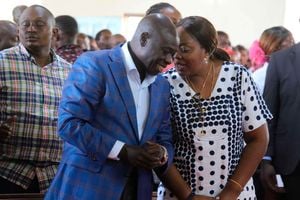
Grade Seven students at Ilmarba Junior Secondary School in Matapato North Ward in Kajiado County during a lesson.
| Francis Nderitu | Nation Media GroupEducation
Premium
Challenges facing junior schools ahead of January Grade 8 roll out
What you need to know:
- Schools will officially close in two weeks’ time, precisely on October 26. Learners in Grade Seven will have completed one year of junior secondary school under the competency-based curriculum (CBC). As they proceed to Grade Eight in January, the Nation set out to estalish how implementation of the newest segment in the education system has fared so far and the quality of education offered to learners.
- According to TSC, about 7,500 teachers who were initially in primary schools but hold bachelor’s degrees were deployed to teach in junior secondary schools but the numbers are still not enough.
Until September, James Koinet* had been the only teacher in junior school at a learning institution in Kajiado Central Sub-county, Kajiado County, when one more teacher was posted there.
“From February when I reported, I’d been handling 13 learning areas whereas at university, I only trained to teach history and Christian Religious Education,” he told the Nation. “I wasn’t trained for learning areas like integrated science, which comprises of physics, chemistry and biology.”
“I didn’t do physics in high school, so I have to research online and use YouTube. Teaching the subjects becomes harder for both the teacher and the learners because there are practical aspects and at first we didn’t have equipment,” Mr Koinet said.
“Because of the many subjects and little rest, I had to make the classroom my office.”
“Apart from fatigue, the learners might also get bored for seeing only one teacher in their class. The new teacher has made it easier. If we get another additional teacher, it’ll be even better,” he said.

Grade 7 students of Kitengela International School during a mathematics class on September 20, 2023.
However, in January 2024, it will be back to the drawing board as the two teachers will have two classes to teach (Grades Seven and Eight). They are also unsure whether their contracts will be renewed.
Deep waters of junior school
Their case mirrors that of thousands of other teachers employed this year by the government and deployed to teach in junior school.
Secondary school teacher trainees specialise in two teaching subjects in university. In all the schools Nation visited, there were no teachers qualified to teach pre-technical skills, one of the core subjects for Junior school.

Teacher Zaituni Chepkrui with her pupils at Bomet Township Primary and Junior Secondary School on September 22, 2023.
Whereas the government initially deployed 36,000 teachers on one-year contracts, there are 19,038 public schools licensed to offer junior school. Later, in September, an additional 20,000 teachers were deployed.
According to the Teachers Service Commission (TSC), about 7,500 teachers who were initially in primary schools but hold bachelor’s degrees were deployed to teach in junior school but the numbers are still not enough. TSC boss Nancy Macharia last week said the teachers were to be retooled between October 6 and 13. Another 75,250 teachers, including headteachers and those deployed from primary to Junior school, are among staff retooled by the TSC this year.
“The fact that our teachers have successfully swam into the deep junior school waters and guided our learners exceptionally well is something we must celebrate today,” Ms Macharia said during the World Teachers Day celebrations on October 5, 2023.
However, based on subject needs, schools still fall short of the requirements and government documents says as much.
“The TSC 2022 baseline survey shows that the immediate demand for JS teachers is 70,430. However, the number is expected to rise to 73,000 in 2023 and will stabilise at 120,923 by 2024, when the teachers recruited over time will constitute an optimum number for the level of education,” reads the report of the Presidential Working Party on Education Reforms (PWPER), 2023.
It serves no purpose at all
Some experts have raised concerns over the quality of education learners in public junior schools are receiving and whether it will meet objectives as set out in the Basic Education Curriculum Framework on which CBC is anchored.
The vice-chancellor of Daystar University, Prof Laban Ayiro, who has done extensive research on implementation of CBC in Kenya highlighted errors that preceded the rollout of junior school.
“You can’t have a pilot of the whole population. Scientifically, that’s not the way to reform an education system but that’s what we’ve done. We were supposed to have piloted on a very small scale to see how this is working. Then when you’re satisfied, you can then do a rollout of the system,” he said.
“The biggest mistake is that we should’ve undertaken teacher preparation. First get the (required) numbers … we should’ve turned some of our teacher training colleges (TTCs) into middle colleges to train these teachers in the various pathways. It’s all about planning. Kenya is not in short supply of teachers. We only needed to re-skill and re-tool them,” Prof Ayiro told the Nation.
“We woke up in the morning and we were already with junior school and there were no teachers. If they [learners] are not being moulded to fit various pathways, then it serves no purpose at all. We might as well evert to the 8-4-4 system. I’m very nervous about our country in so far as education is concerned,” he added.
Ironically, private primary schools that Nation sampled are adequately staffed and have the requisite infrastructure as stipulated in the Ministry of Education guidelines.
“It’s interesting that the government developed the guidelines for junior school but private schools are implementing them way better than public ones. Most of these children aren’t learning what they’re supposed to be learning and they’ve been given a very weak foundation before going to senior school.”
“We expect 50 per cent to go into Stem [science, technology, engineering and mathematics], where will they come from?” posed Mr Emmanuel Manyasa, the executive director of Usawa Agenda.
Also Read: The evolution of Kenya’s education system
Not prepared adequately
The headteacher of a primary school in Bomet County told Nation the Junior school teachers were not prepared adequately to perform their duties.

Ntinyika Primary School Teacher Mike Solitei (front of the class) teaching grade 6 on the subject of Social Studies at the school on September 21, 2023.
“I sympathise with their situation. Many of them are just doing the job with the hope that they’ll be absorbed on permanent basis while others are looking for jobs elsewhere. Some of them are also uncomfortable with my supervision because I don’t have a degree but earn more than them,” he said.
The distribution of the teachers was done based on the number of streams schools have with an average of one teacher per stream. For example, Olympic Primary School in Kibra Sub-county in Nairobi has 962 Junior school learners in eight streams was allocated eight teachers, still way below the recommended number.
“An optimum operating Junior school (one stream) should have 180-210 learners, with a class size of 60-70 learners per class. This requires six teachers and three classrooms. The estimated cost is Sh7,800,000. A Junior school with less than 180 learners is considered very inefficient,” reads the PWPER report.
A senior quality assurance officer in the Mt Kenya region who spoke to Nation on condition of anonymity said that the directorate is understaffed and is unable to monitor the quality of teaching in schools. She also said the field officers do not have vehicles to travel to various schools.
“We need to go back to the drawing board. Next year, we’ll have another junior school class and the government must think outside the box to avert further crisis. There’s an imbalance in the distribution of teachers in terms of their specialisations. Most of them are only qualified to teach humanities. The recruitment should be subject-based and not on the basis of the year of graduation but it’s still impractical for one teacher to effectively teach all those subjects,” she said.
Many Junior school institutions that have senior secondary schools nearby, she pointed out, have made arrangements to have the secondary school teachers helping with some of the lessons.
Many teachers who talked to Nation said they were lagging behind in syllabus coverage and feared the Grade Seven workload will be carried forward to Grade Eight. Alongside staffing challenges, the problem was also attributed to late delivery of teaching and learning materials for Junior school.
“I’d like Junior school institutions to be ring-fenced so that they have nothing to do with the management of their host primary schools or the neighbouring secondary schools,” Prof Ayiro said.
Describing the roll out as “a very intense experiment we’re undertaking”, Prof Ayiro added that the learners must be allowed to demonstrate their “leanings and their preferences and be able to slot them in the pathways.”
“It must be a very controlled environment. I’d have been nervous for them to go to high school at that age but I’m also nervous for them to be in primary school, which lack the capacity to turn them into what we wanted them to become. The capacity is simply not there,” he said.
Rev Dr Tarsilla Kibaara, a lecturer at Kenya Methordist University in Meru County, recently carried out research on the implementation of Junior school in south coast and her findings were equally damning.
“As we wait for senior secondary school, something needs to be seriously done. The foundation of a learner greatly matters. The first (CBC) lot we will receive in universities will have major (learning) gaps which we need to prepare for because these are the people we’ll give back to the society,” she said during a forum for deans of schools of education from universities.
Mr Elijah Koitalel, the headteacher of Maparasha Primary School, said the institution originally had one teacher for the two streams but an additional two others have been posted.

Maparasha Primary and Junior Secondary School Principal Elijah Koitalel speaks during the interview on September 21, 2023.
“They have shared lessons among the three but the teaching load is still high. However, we’re better off than others who have one or two. When they reached here, we didn’t consider their teaching subjects because of the shortage of staff. A teacher is a teacher despite their specialisation especially when there’s a shortage at the working station. I’d have preferred to have at least four more teachers in that class,” Mr Koitalel said.
He said that the school does not have a single laboratory but makes use of those at the neighbouring secondary school. However, the school has a few rudimentary equipment for practicals in one of the rooms which also serves as a store for the tablets supplied under the Digital Learning Programme by the previous regime. However, most of them are dysfunctional or broken.

Some of the desktop computers used in the ICT/Computer Room at Maparasha Primary and Junior Secondary School on September 21, 2023.
“The capitation is not enough because the cost of living and that of goods has gone up. Learning materials are also expensive but it’s better compared with the capitation for primary school learners,” Mr Koitalel said.
He added that schools in the county are negatively affected by capitation based on enrolment in the National Education Management Information System (Nemis). To register learners on the system, they must hold a birth certificate which many lack.





